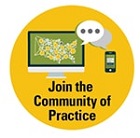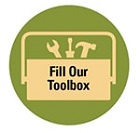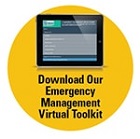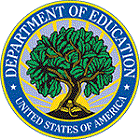|
Building Your Preparedness for Hazardous Materials, Toxins, and Toxic Materials

Every day, K-12 schools and institutions of higher education (IHEs) show their deep dedication to keeping their whole school/campus community, including students, teachers/faculty, staff, families, and visitors, safe across various learning environments. Comprehensive planning for all settings, times, threats, and hazards is foundational to school safety. Integrating school safety into everyday activities helps create a culture of preparedness that can also lead to an increased level of safety for children at home and in the community. While helping to raise awareness of the hazard, schools and IHEs can continually build their capacity by incorporating poison-related prevention, mitigation, ongoing protection, response, and recovery activities in their school emergency operations plans (EOPs).
In 2019, there were more than 2 million cases of human exposure to poison across the United States, and 300,000 involved children/teens ages 6-19.i Do you know what is poisonous on your campus? Cleaning solvents and other potentially toxic materials may be found within custodial closets and storage rooms. Art supplies may contain harmful chemicals. Cleaning supplies and other strong chemicals may be stored in the kitchen and/or use insufficient containers. Chemistry laboratories may contain highly toxic chemicals. Pesticides, especially those administered during school/IHEs hours, may be poisonous. These are just some examples of poison that can be found in the school and/or campus setting.
Poison can be a cascading effect of a variety of hazard types and emergencies, including accidental releases of hazardous materials from within the school/IHE (e.g., lead, radon), explosions or accidental release of toxins from industrial plants (e.g., fire at a fertilizer plant), hazardous materials releases from major highways or railroads (e.g., oil spill), and toxic materials present in school laboratories (e.g., mercury, concentrated acid). These biological and technological hazards can each be addressed via hazard-specific annexes in an EOP, as well as in seasonal and year-round activities.
Engage in National Poison Prevention Week
The REMS TA Center invites you to consider participating in National Poison Prevention Week, which is taking place now through March 27, to jump-start your hazardous materials, toxins, and toxic materials planning activities and enhance your knowledge on this important topic. Initiated in 1962, this awareness week aims to reduce unintentional poisonings and serves as an informal learning opportunity for you, your team, and your school/IHE. Furthermore, it offers a moment to refocus your information dissemination efforts, connect with members of your school/campus community, and build your preparedness capacity. Below are sample activities that you can engage in as a part of National Poison Prevention Week.
- Share information on the dangers of poisonings and resources on poison prevention. Help spread the word via your school Website, blog, social media account, or other mediums. Teach members of your community how to talk about poisons, prevent poisoning, and respond to a poisoning emergency. Find resources, including toolkits, infographics, videos, a public service announcement, and other materials, on the Poison Help Website.
- Download materials for National Poison Prevention Week, and incorporate them into your outreach activities. Use #MakeTheRight Call creative materials on your social media channels, and access other publicity materials that address promoting your National Poison Prevention Week events. The REMS TA Center also offers creative materials that can help showcase and build your safety leadership throughout the year.
- Save the Poison Help Line Phone Number: 1-800-222-1222. Did you know that the U.S. Department of Health and Human Services (HHS), Health Resources and Services Administration (HRSA) funds a toll-free Poison Help line to connect callers to their local poison center? Add this phone number, which was introduced in 2002, to your quick reference guides, applicable EOP annexes, and other engagement and communication materials across your campus/school.
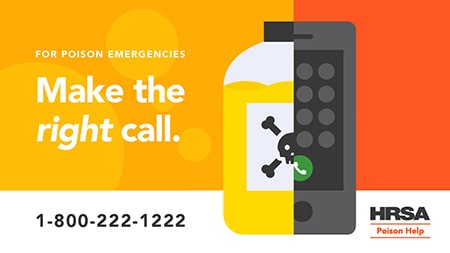
- Connect with your local/state poison center, which may be supported by an IHE in your area. Not only can they assist you with a poisoning emergency, but poison centers can provide educational materials, expert advice, and free and confidential help. Find your state/local poison center to learn about its outreach events and plans for National Poison Prevention Week and how you can collaborate together to raise awareness.
- Strengthen your poison plans. Using the six-step planning process outlined in the School Guide, District Guide, and IHE Guide, review and update your existing or develop hazardous materials, toxins, and/or toxic materials annex(es). Find resources that support these hazards from our Technological Hazards Resources or Biological Hazards Resources pages.
Utilize Resources From Federal Partners
As your National School Safety Center, the REMS TA Center is dedicated to helping you with your safety, security, emergency management, and preparedness programs and plans that ultimately support your school ethos. Celebrate National Poison Prevention Week, and your preparedness for poison-related emergencies, by referencing and sharing the resources and tools below. These resources are brought to you by Federal partners, the REMS TA Center, and our collaborative work together and are designed to help school and campus leaders and planning teams, with their community partners, prepare for emergency events that relate to toxic materials, hazardous materials, toxins, and poison.
Lead in Schools
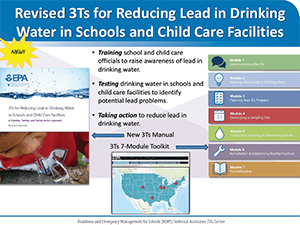 Impacts of Lead Exposure on Learning and Integration Into School Emergency Management Planning Webinar, REMS TA Center and U.S. Department of Education, in collaboration with U.S. Environmental Protection Agency (EPA). Highlights the impacts of lead exposure on the learning environment and steps education agencies can take to integrate lead testing and reduction programs into school emergency management planning and EOPs. Impacts of Lead Exposure on Learning and Integration Into School Emergency Management Planning Webinar, REMS TA Center and U.S. Department of Education, in collaboration with U.S. Environmental Protection Agency (EPA). Highlights the impacts of lead exposure on the learning environment and steps education agencies can take to integrate lead testing and reduction programs into school emergency management planning and EOPs.
- 3Ts for Reducing Lead in Drinking Water Toolkit, EPA. Offers school-centered tools and information on implementing voluntary lead in drinking water testing programs, including training personnel to raise awareness of lead in drinking water, testing drinking water to identify potential lead problems, and taking action to reduce lead in drinking water.
Mercury and Laboratories
-
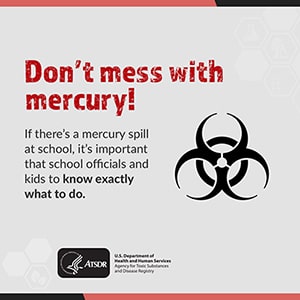 Don't Mess with Mercury — A mercury spill prevention initiative for schools, HHS, Centers for Disease Control and Prevention (CDC), Agency for Toxic Substances and Disease Registry. Contains information, videos, lesson plans (grades 6-8), and other resources for teachers, school staff, and students to use to support preventative measures relating to mercury in the school environment. This tool is available in the Spanish language.
Don't Mess with Mercury — A mercury spill prevention initiative for schools, HHS, Centers for Disease Control and Prevention (CDC), Agency for Toxic Substances and Disease Registry. Contains information, videos, lesson plans (grades 6-8), and other resources for teachers, school staff, and students to use to support preventative measures relating to mercury in the school environment. This tool is available in the Spanish language.
- School Chemistry Laboratory Safety Guide, U.S. Consumer Safety Product Commission and HHS, CDC, National Institute for Occupational Safety and Health. Provides considerations for teachers and students, and information on data sheets, chemical purchases, hygiene plans, tracking systems, container labels, storage, and disposal.
Chemicals and Poison
- Chemical Management Resource Guide for School Administrators, EPA. Offers guidance on how to address hazardous chemicals and products in schools; policies and actions to prevent spills; and special considerations for certain chemicals, such as lead, asbestos, mercury, and arsenic in schools.
- Creating Healthy Indoor Air Quality in Schools, EPA. Contains best practices, publications, and archived Webinars on managing indoor air quality in schools and maintaining healthy indoor learning environments.
- Poison Help, HHS, HRSA. Contains information on what you can do, frequently asked questions, and poison centers, as well as resources on poisoning and poison-related emergencies.
Emergency Management Planning
- Incorporating Chemical Hazards Into an Emergency Management Plan, REMS TA Center. Captures lessons learned from a school district that experienced a chemical spill, including products that contain hazardous ingredients and partners for addressing chemical hazards and their potential contributions.
- Campus Resilience Program Exercise Starter Kits, U.S. Department of Homeland Security. Contains tabletop exercise materials for a hazardous material release scenario at an IHE.
- School EOP Planning 101: Creating High-Quality School Emergency Operations Plans (EOPs) That Address All Threats, Hazards, Settings, and Times Webinar, REMS TA Center. Presents the key concepts, principles, and process for use by K-12 schools and school districts, in collaboration with their community partners, to create high-quality school EOPs that integrate planning around all threats and hazards and all settings and times.
Participate on Social Media
Follow @remstacenter on Twitter to stay informed about activities throughout National Poison Prevention Week! Also follow our Federal partner @HRSAgov as well as the #MakeTheRightCall hashtag to access additional information and resources.
|





